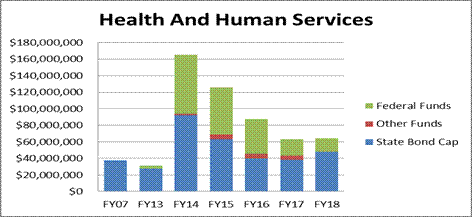FY2014 - FY2018 Capital Investment Plan
Report - Investment Category - Health and Human Services
The Executive Office of Health and Human Services (HHS) provides
the safety net for the Commonwealth’s most vulnerable citizens. The 16
agencies of HHS provide critical services to veterans, elders, children, the
mentally ill, and the developmentally disabled. HHS agencies administer the
Commonwealth’s Medicaid program, MassHealth, programs at the Department of
Public Health, comprehensive disability services, and the Department of
Transitional Assistance, among others.
More than 700 buildings are operated or occupied by HHS agencies,
encompassing over 10 million square feet of space and spread over 36
state-owned properties. These structures include hospitals, clinics, long and
short-term care facilities, regional offices, as well as support facilities
like power plants and garages. Many of these facilities operate 24 hours per
day, 7 days per week, year-round. In addition, information technology (IT)
solutions throughout HHS agencies support over 800 applications and 20 enterprise
systems that serve mission-critical functions such as program eligibility
determination, case management efficiencies, and financial management
services. In past years, IT funding had been separated into a separate
category. Beginning in FY14, HHS IT spending is being shown in this section to
further the Administration’s efforts to show spending in a programmatic form that
is both transparent and delivers truth in government spending. This
integration results in the large increase in federal spending shown in the
chart below.
The following graph reflects the Administration’s estimated
capital investment in health and human services capital projects and programs
over the next five years, as compared to fiscal years 2007 and 2013 health and
human services related spending.

Administration Accomplishments to Date
-
The Worcester Recovery Center and Hospital (WRCH) was the first new mental health facility to
open in the Commonwealth in decades. This 320 bed state-of-the-art facility
exemplifies the new model of mental health care which encourages recovery
rather than prolonged hospitalization. Moreover, the WRCH was designed to meet
LEED Gold certification for its “green” design and construction.
-
Improvements to HHS’s information technology and business systems have resulted in better case
management, integrated means testing, and electronic health records for
Medicaid clients. These improvements enhance program integrity, improve
coordination of care for patients, and are central to efforts that lower health
care costs.
-
In order to serve individuals with disabilities in smaller, more personal settings,
community-based residences have been or are being constructed to replace four
large residential Department of Developmental Services’ (DDS) campuses. Recently,
12 state-supported residences have opened in the community to serve clients
from the closed Monson Developmental Center facility.
-
IT capital funding has helped support the implementation of the Commonwealth’s first Health Information
Exchange. The first phase has created the Mass HiWay infrastructure and
enabled the secure exchange of health information from one hospital or provider
to another, irrespective of provider affiliation, location, or differences in
technology. This new exchange allows health information to be securely
transmitted between health care providers and organizations, assisting in the
coordination of care, improving patient safety, and is a critical factor in
lowering health care costs in the Commonwealth. At the end of August 2013,
nearly 1.5 M transactions have been securely transmitted over the Mass HiWay.
-
Completed in 2012, the VOIP (Voice Over Internet Protocol) project overhauled the telephone
systems for the more than 23,000 employees throughout HHS. This project replaced
many duplicative and near end-of-life systems with a single state-of the-art
system based on modern and cost-effective networking technologies.
FY 14 Highlights
-
The Commonwealth will renovate and expand the historic Goss Building on the Taunton
campus of the Department of Youth Services (DYS) to meet the agency’s current
and future needs. Upon completion, the Goss Building will accommodate the
long-term needs for DYS and the 80 bed facility will become the center of the
agency’s operations in the southeast region of the Commonwealth. The renovated
youth complex will support the DYS mission through the appropriate combination
of modern residential, educational, recreational and administrative space.
-
Similar in scope to the DYS Goss Building initiative, the DYS Center in Middleton will
provide a new, 45 bed residential facility at the existing site in Middleton
and become the center of DYS operations in the northeast region of the state.
With its enhanced capacity, youth in custody at Middleton will be ensured a
safe and secure environment with the full complement of educational and
recreational opportunities.
-
In order to serve individuals with disabilities in smaller, more personal
settings, three new community-based residences are being constructed on the
Templeton Developmental Center campus. Consistent with the Administration’s
Community-First principles and the move away from institutionalization, the
construction of these homes on the Templeton grounds will coincide with the
closure of the Templeton Facility Campus.
-
Located near the entrance of the Department of Mental Health’s (DMH) new Worcester
Recovery Center and Hospital, the Worcester Clock Tower reconstruction will
continue through FY15. When completed, the project will provide additional
green space and landscaping, improved access, and preserve the significant and
historic landmark for the Worcester community.
-
To continue progress and maintain its national leadership in the Health IT sector,
the Commonwealth will continue investment in the Health Insurance Exchange and
Integrated Eligibility System (HIX/IES), a critical component of the
Commonwealth’s compliance with the Affordable Care Act (ACA), which will fully
integrate access to MassHealth and Health Connector programs and ultimately
expand this “one stop shopping” to include other programs like SNAP and TANF.

